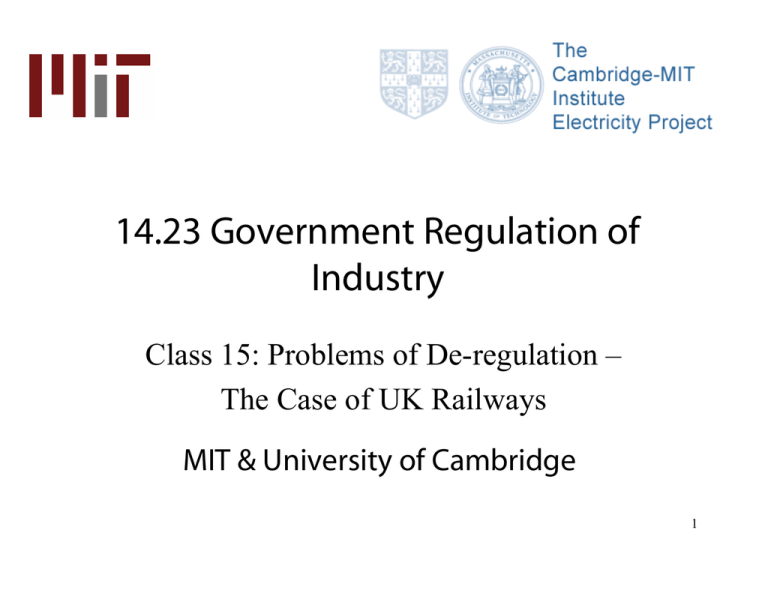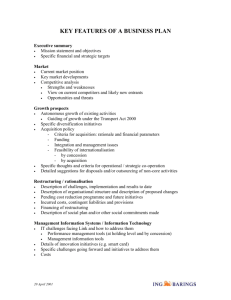Document 13572876
advertisement

14.23 Government Regulation of Industry Class 15: Problems of De-regulation – The Case of UK Railways MIT & University of Cambridge 1 Outline • • • • • • History of UK Railways Privatisation and Restructuring Regulation Performance since Privatisation Recent Failures Lessons 2 Historical background • 1820s onwards railway network privately financed. • 1948 industry nationalised then privatised between 1995 and 1997. • 1948-95 secular decline in rail (passenger and freight) due to road competition. • 1960s mileage reduced by a third (Beeching cull). • 1968-1985 rising subsidies £1.6bn in 1985/86, up from £600m (in constant prices) in 1968 – Low productivity growth and sharp wage increases in 1970s. – Government keen to avoid further line closures. • 1980s significant privatisation of non-core businesses e.g.hotels, sea transport. • 1994-97 privatisation of all of industry. • 1995- trend decline reversed since privatisation. 3 Privatisation • 1979-97 Conservative policy: easy privatisations first, then more difficult. • 1992 White Paper and Conservative aim to make rail privatisation irreversible. • Structure adopted chosen to maximise competition (electricity model). • Main change was separation of track ownership from train operation. • Two regulatory bodies created (OPRAF (now SRA) and ORR). • In all 100 companies created out of BR. 4 Financing and Regulation of Industry • Regulation: OPRAF and ORR (Office of the Rail Regulator). • OPRAF administers subsidies to Train Operating Companies (TOCs). • TOCs purchase track and station access from Railtrack (the monopoly track infrastructure provider) at regulated tariffs. • Rolling stock leasing companies (ROSCOs) lease trains to TOCs • Passenger Fares regulated • Competition envisaged on existing routes. • SRA (Strategic Rail Authority) has since taken over role of OPRAF. • Some direct grant to Railtrack now being given 5 Britain’s Railways: Sources and Uses of Funds (1997/98) Sources: £6,200m* £2,400m Government Subsidy £100m Other income** £600m Freight user Revenue £3,100m Passenger fare revenue Uses: £6,200m* Industry profit £600m Train operating costs (TOCs and freight operators) £2,600m Rolling stock lease payments (ROSCOs) £600m Infrastructure costs (Railtrack) £2,400m * 2001 prices ** Railtrack property income Source: Smith (2003) 6 Regulation of TOCs • • • • • • • • • TOCs have licences and a stream of subsidies and price controls. TOCs are under threat of franchise loss (e.g.Connex South Central). The initial price control period ran to 2003 (end of franchises). Regulation of many fares plus quality of service through performance penalties. RPI-X Regulated fares: saver, weekly season and most commuter fares (40% of revenue). X=0, 1996-98; X=1 (98-03), in commuter markets -2 to +2 for quality. Punctuality incentive scheme, short formations incentive payment, timetable change incentive payment. Many TOCs have struggled to break even and there has been a lot of consolodation. Between 1995-00 fares rose by 0% while 1990-05 rose by 12% on average (in real terms). 7 Regulation of Railtrack • • • • • • • • CP1 (control period) track access charges fixed to 2000-01. CP2 track access charges 2001-06. Under CP1 Railtrack: RPI-8 in 1995-96, then RPI-2. Under CP2 Railtrack: RPI-11.2 in 2001-02, then c. RPI+4.5 on charges, plus direct grant (of £800m p.a.) implies RPI+34.5 in 200102, then c.RPI+4.5. Track access charges consist of a fixed and a variable element for each TOC (usage charge+traction charge). Under CP1 the variable element was around 9%. Under CP2 variable=20% of the amount paid by the TOCs. Freight only paid for its own specific costs. 8 Key trends (1) Passenger Rail Travel 45.0 40.0 Passenger km (bn) 35.0 30.0 25.0 20.0 15.0 10.0 5.0 0.0 1952 • 1959 1966 1973 1980 1987 23% growth in passenger miles since privatisation (1993 to 2001). 1994 2001 9 Key Trends (2) - Costs Table: Graphic Removed Sources: BR Annual Reports; Annual Reports for individual companies (post privatisation). Transport Trends, 2001 Edition (DTLR). • • • • Costs are operating costs (excluding depreciation). Excludes minor freight operators But also excludes profits of supplier companies ORR costs charged out to industry; SRA costs included. Dept of Transport costs not included 10 Key Trends (3) Service Quality Percentage of trains arriving on time (All operators) Pre-privatisation 95% Post-privatisation Post-Hatfield 90% Charter punctuality measure 85% New public performance measure (PPM) 80% 75% 70% 92/93 93/94 94/95 1995/96 1996/7 1997/98 1998/99 1999/00 2000/01 11 2001/02 Graphic Removed Source: Railway Safety (2002), http://www.railwaysafety.org.uk/pdf/railrepo0102/aspr%20200102%20full%20report.pdf 12 Methodology used for assessment Methodology • Social cost-benefit analysis. Calculation • • Outlined by Jones, Tandon and Vogelsang (1990). Compute difference between costs under public and private ownership. ∆W = Cg - Cp - R&P • Adopted for many other privatised industries in UK and overseas. • Main difficulty lies in estimating the counterfactual cost profile. • Assesses total welfare change distribution. • Total welfare change then allocated between different groups. ∆W = Vsp - Vsg + (λg - lp) * Z • Privatisation socially worthwhile if ∆W>0. ∆W = ∆Cust + ∆Prod + ∆Gov 13 Results: actual and counterfactual costs FIGURE 4 Actua l a nd Counte rfa ctua l Tota l Costs 5000 Pro-priv atis ation (0% gain) £m ( 1999/00 pr ice s ) A c tual c os ts 4500 Central (1% gain) 4000 Pro-public (2% gain) 3500 3000 88/89 89/90 90/91 91/92 92/93 93/94 96/97 97/98 98/99 99/00 14 Results: profiling of savings Discount rate 6% Fut. Total 1,900 (1,400) 500 3,300 - 800 (1,400) (600) (200) (1,400) (1,600) To date Pro-privatisation scenario Efficiency gains Restructuring costs Net efficiency gain/(loss) Central scenario Efficiency gains Restructuring costs Net efficiency gain/(loss) Pro-public scenario Efficiency gains Restructuring costs Net efficiency gain/(loss) To date 10% Fut. Total 5,200 (1,400) 3,800 2,000 (1,700) 300 2,800 - 4,800 (1,700) 3,100 1,700 - 2,500 (1,400) 1,100 800 (1700) (900) 1,400 - 2,200 (1700) 500 100 - (100) (1,400) (1,500) (200) (1,700) (1,900) 0 - (200) (1,700) (1,900) 15 Results: distribution of benefits: government • • • • • Government receives/producers pay sales proceeds (£7bn). Government receives taxes on future profits (small effect). And pays subsidies Counterfactual: government pays subsidies to cover losses. Overall, government’s position broadly neutral. Rail Privatisation proceeds Railtrack * ROSCOs Freight Infrastructure & Maintenance cos. BR Central Services Total * Includes £596m of debt. £bn (current prices) £bn (present value) 2.5 1.7 0.3 0.3 0.2 5.0 3.5 2.4 0.4 0.4 0.3 7.0 16 From Promise to Crisis • October 1999 Ladbroke Grove (near Paddington) Crash. • July 2000 Government 10 year transport plan indicates further growth in rail network usage to 2010 of 50%. • October 2000 Hatfield (north of London) Crash. • Hatfield causes severe disruption of network. • April 2001 Regulator agrees that Railtrack may bring forward revenue from future. • April-May 2001 Railtrack privately seeks more government money to finance operations. • October 2001 Secretary of Transport places Railtrack in special administration • October 2002 Network Rail, a not for profit company limited by guarantee, takes over network assets. • Late 2002-03 indications from SRA that future investment plans will have to be cut and government targets for increased rail use will not be met. 17 Funding problems at Railtrack • Following Hatfield Crash it became clear that Railtrack needed more finance and that CP2 was too harsh. Hatfield cost £500m of repairs and £500m of TOC compensation. • In April 2001 government agreed with Railtrack to bring forward £1.5bn from CP3 (beyond 2006-7). • This money was not forthcoming as the government could not find a way of transferring it without it ending up on the PSBR. • This contributed to the funding shortfall which led to being brought into administration. 18 Problems with the TOCs • ROSCOs did not invest in new rolling stock as expected. • TOCs needed extension of franchises in order to get incentives to invest in new rolling stock (e.g. Virgin). • TOCs also required some infrastructure investment to complement their investment (e.g. Virgin, Heathrow Express). • Some TOCs had clearly been ambitious on bidding for subsidy reduction and this led to consolidation in industry. • Other TOCs demonstrated incompetence in running services and lost franchise (however this could be a benefit of competition). • Too many TOCs – some combinations being franchised from 2003. • However Affuso et al (2002) demonstrate a big improvement in TOC efficiency as a result of privatisation due to lower costs and higher revenue. 19 Incentive Problems • Strong TOC incentive to run more trains. • Extra revenue to Railtrack did not cover marginal costs, hence recent increase. • 1% rise in trains leads to 2.5% increase in congestion. • Negotiations to reallocate access rights to most efficient use and allow Railtrack to take share of benefit have proved costly and slow. • Maintenance contracts fixed price (set prior to privatisation) leading to focus on cost minimisation. 20 Evaluating Quality: Punctuality • • Performance deteriorated during the growth period of the 1980s. So likely that performance would have been worse under public ownership. Train Performance and Volume: Post-Privatisation Performance Punctualitya Pass. Train miles (m) Pass. Miles (bn) 95/96 96/97 97/98 98/99 99/00 Change 89.5% 231 18.6 92.5% 229 19.9 92.5% 237 21.6 91.5% 249 22.6 91.9% 257 23.8 + 2.7% + 11% + 28% 88/89 89% 222 21.3 Change (1%) + 10% + 15% (a) Percentage of trains on time. Train Performance and Volume: BR Regime Performance Punctualitya Pass. Train miles (m) Pass. Miles (bn) 84/85 90% 202 18.5 85/86 89% 201 18.9 86/87 90% 203 19.2 87/88 90% 213 20.1 (a) Percentage of trains on time. 21 Evaluating Quality: Railway Safety • Evans (2000) and (2002) finds accidents per billion train miles is on a trend decline over the period 1967-2001. • This is the case even including the latest period. • However some suggestion that the number of fatalities per accident is mildly increasing in speed and over time. • However it is impossible to say that privatisation led to any increase in fatalities. • Intermediate indicators of safety such as number of signals passed at danger (the cause of the Ladbroke Grove Crash) and number of broken rails (the cause of the Hatfield Crash) have declined sharply over the privatisation period. 22 Lessons • Privatisation good at getting costs down and output up. • Regulation may create perverse incentives. – Fixed contract prices for maintenance – Low marginal prices for Freight and TOCs • In general: keep privatisation and restructuring simple. • Privatisation may reduce willingness to accept risk – this could be expensive. • Privatisation almost certainly reduces political acceptability of subsidies. 23 Next • The De-regulation of Californian Electricity • Read Joskow, P.; "California's Electricity Crisis;" Oxford Review of Economic Policy, Vol.17, No.3; pp. 365-388. 24

